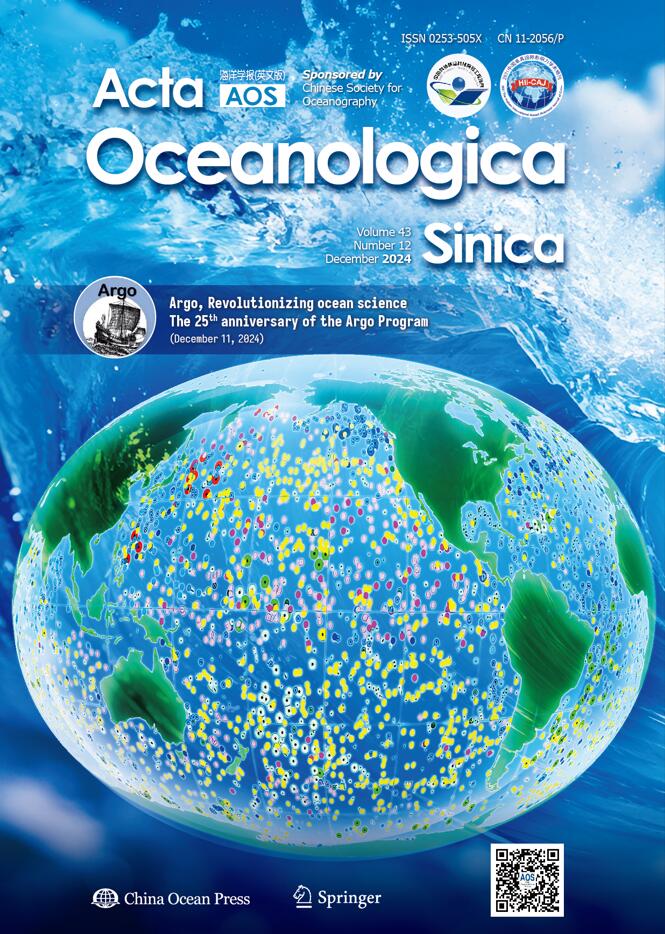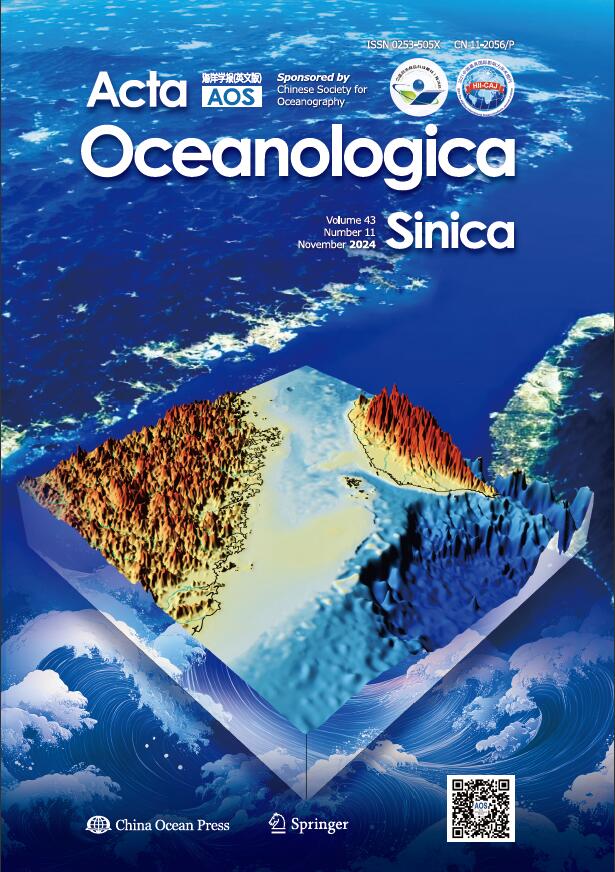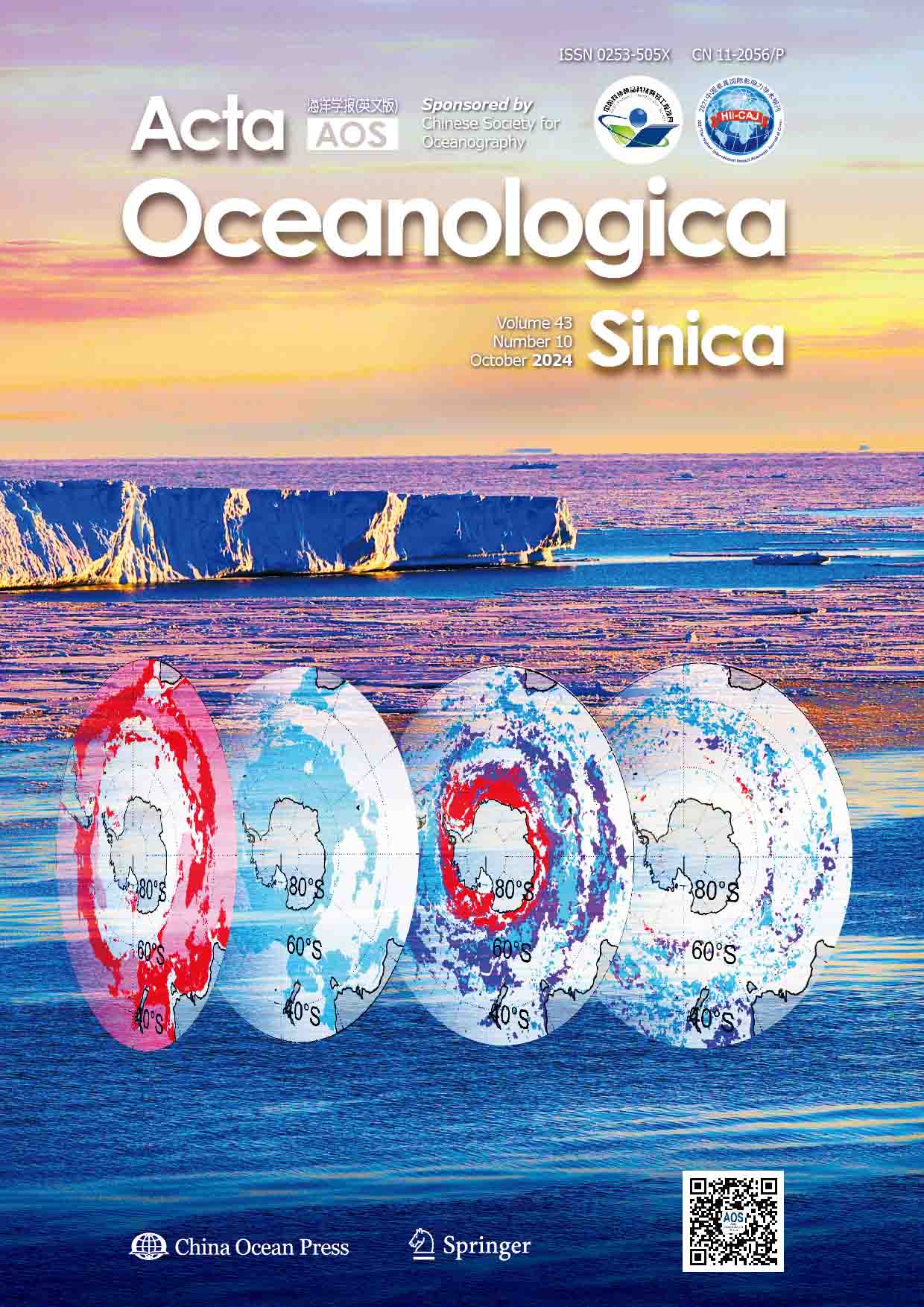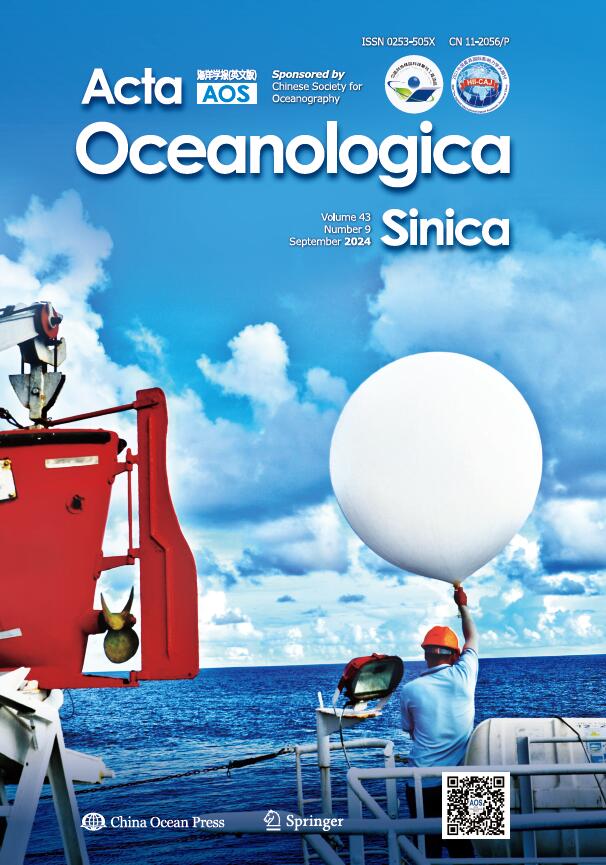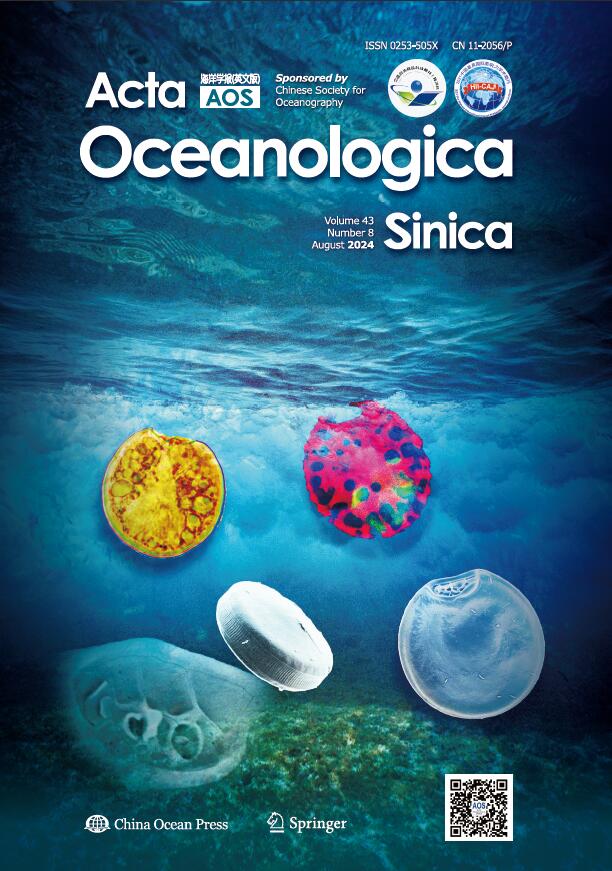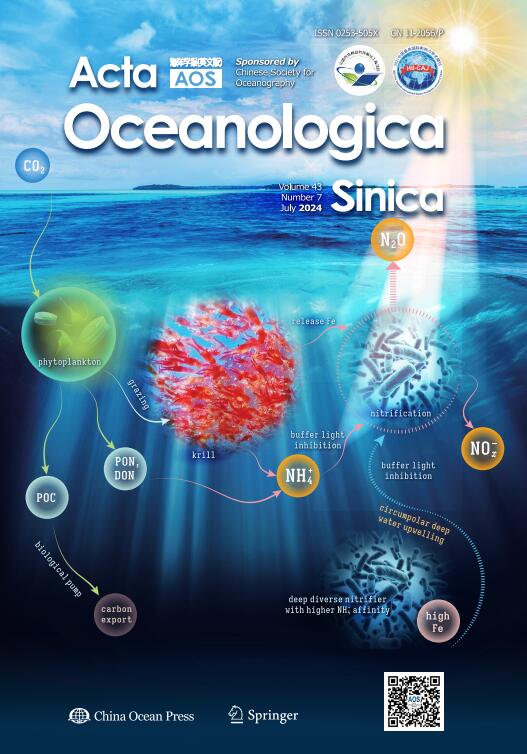LOGIN
Most Cited
- Green synthesis of iron oxide (Fe3O4) nanoparticles using two selected brown seaweeds: Characterization and application for lead bioremediation
- A nowcasting model for the prediction of typhoon tracks based on a long short term memory neural network
- The first Sentinel-1 SAR image of a typhoon
- Effect of temperature, salinity and irradiance on growth and photosynthesis of Ulva prolifera
- Sediment discharge of the Yellow River, China: past, present and future-A synthesis
Articles in press have been peer-reviewed and accepted, which are not yet assigned to volumes /issues, but are citable by Digital Object Identifier (DOI).
Display Method:
Accepted Manuscript
, Available online 2025-03-27 17:04,
doi: 10.1007/s13131-024-0002-5
Abstract:
Swells are critical concerns regarding safety, marine transportation, and coastal engineering construction of coastal countries along the Gulf of Guinea and have been scientific problems due to the lack of systematic theoretical, numerical, and obser...
Swells are critical concerns regarding safety, marine transportation, and coastal engineering construction of coastal countries along the Gulf of Guinea and have been scientific problems due to the lack of systematic theoretical, numerical, and obser...
Accepted Manuscript
, Available online 2025-03-27 13:24,
doi: 10.1007/s13131-024-0002-3
Abstract:
Significant wave period is an important parameter in coastal and offshore engineering design. Traditional spectral wave models do not directly calculate this parameter, which means that it needs to be estimated from the spectral periods using empiric...
Significant wave period is an important parameter in coastal and offshore engineering design. Traditional spectral wave models do not directly calculate this parameter, which means that it needs to be estimated from the spectral periods using empiric...
Accepted Manuscript
, Available online 2025-03-25 20:44,
doi: 10.1007/s13131-024-0002-1
Abstract:
Coral gardening has become a promising technique for restoring reefs worldwide in the Anthropocene era. The microbiome plays an important role in enhancing adaptive resilience in situ nursery propagation of corals. However, little is known about the ...
Coral gardening has become a promising technique for restoring reefs worldwide in the Anthropocene era. The microbiome plays an important role in enhancing adaptive resilience in situ nursery propagation of corals. However, little is known about the ...
Accepted Manuscript
, Available online 2025-03-25 16:59,
doi: 10.1007/s13131-024-2401-1
Abstract:
The present investigation aims at unveiling the main causes of the recorded disparate phylogeographic patterning among the two highly dispersive coastal crab species Carcinus aestuarii and Pachygrapsus marmoratus in the Mediterranean Sea. For this pu...
The present investigation aims at unveiling the main causes of the recorded disparate phylogeographic patterning among the two highly dispersive coastal crab species Carcinus aestuarii and Pachygrapsus marmoratus in the Mediterranean Sea. For this pu...
, Available online 2025-03-25 09:02,
doi: 10.1007/s13131-024-2424-6
Abstract:
Marine Heatwave (MHW) events refer to periods of significantly elevated sea surface temperatures (SST), persisting from days to months, with significant impacts on marine ecosystems, including increased mortality among marine life and coral bleaching...
Marine Heatwave (MHW) events refer to periods of significantly elevated sea surface temperatures (SST), persisting from days to months, with significant impacts on marine ecosystems, including increased mortality among marine life and coral bleaching...
Accepted Manuscript
, Available online 2025-03-24 16:47,
doi: 10.1007/s13131-024-0001-9
Abstract:
Macrobenthos can serve as an indicator of hypoxia in the estuarine ecosystem. This comparative study surveyed macrobenthos from hypoxic and non-hypoxic areas of the Pearl River Estuary (PRE), and explores the effects of environmental factor on the ma...
Macrobenthos can serve as an indicator of hypoxia in the estuarine ecosystem. This comparative study surveyed macrobenthos from hypoxic and non-hypoxic areas of the Pearl River Estuary (PRE), and explores the effects of environmental factor on the ma...
Accepted Manuscript
, Available online 2025-03-24 16:12,
doi: 10.1007/s13131-024-2403-y
Abstract:
Large yellow croaker (Larimichthys crocea) is an economically important fish, with the annual production ranking second among maricultured fish in China. Outbreaks of visceral white nodules disease caused by Pseudomonas plecoglossicida have led to su...
Large yellow croaker (Larimichthys crocea) is an economically important fish, with the annual production ranking second among maricultured fish in China. Outbreaks of visceral white nodules disease caused by Pseudomonas plecoglossicida have led to su...
Accepted Manuscript
, Available online 2025-03-24 15:10,
doi: 10.1007/s13131-024-2411-y
Abstract:
In this study, we aimed to isolate potential Bacillus strains from the digestive tract of Nile tilapia (Oreochromis niloticus). Through morphological, biochemical, 16S rDNA sequencing, and evolutionary relationship assessments, we identified the isol...
In this study, we aimed to isolate potential Bacillus strains from the digestive tract of Nile tilapia (Oreochromis niloticus). Through morphological, biochemical, 16S rDNA sequencing, and evolutionary relationship assessments, we identified the isol...
Accepted Manuscript
, Available online 2025-03-21 10:10,
doi: 10.1007/s13131-024-2443-3
Abstract:
The impacts of the Luzon Strait transport on shallow meridional overturning circulation (SMOC) in the South China Sea (SCS) have been pointed out by previous studies, but the issue whether the Luzon Strait transport dominates the SMOC formation still...
The impacts of the Luzon Strait transport on shallow meridional overturning circulation (SMOC) in the South China Sea (SCS) have been pointed out by previous studies, but the issue whether the Luzon Strait transport dominates the SMOC formation still...
Accepted Manuscript
, Available online 2025-03-20 17:10,
doi: 10.1007/s13131-024-2366-z
Abstract:
The symbiotic association between reef-building corals and Symbiodiniaceae is pivotal for coral reef ecosystems, yet remains susceptible to environmental factors. Currently, there is a dearth of research examining seasonal fluctuations in coral-assoc...
The symbiotic association between reef-building corals and Symbiodiniaceae is pivotal for coral reef ecosystems, yet remains susceptible to environmental factors. Currently, there is a dearth of research examining seasonal fluctuations in coral-assoc...
Accepted Manuscript
, Available online 2025-03-20 17:10,
doi: 10.1007/s13131-024-2390-z
Abstract:
Melt ponds are significant physical features on the ice surface throughout the Arctic summer, and the scarcity of observational data has resulted in a vague understanding about it. This study employs satellite data and multi-model averaged outputs fr...
Melt ponds are significant physical features on the ice surface throughout the Arctic summer, and the scarcity of observational data has resulted in a vague understanding about it. This study employs satellite data and multi-model averaged outputs fr...
Accepted Manuscript
, Available online 2025-03-19 18:19,
doi: 10.1007/s13131-024-0001-4
Abstract:
Polynyas and their adjacent seasonal ice zones (SIZs) represent the most productive regions in the Southern Ocean, supporting unique food webs that are highly sensitive to climate change. Understanding the dynamics of phytoplankton and the carbon poo...
Polynyas and their adjacent seasonal ice zones (SIZs) represent the most productive regions in the Southern Ocean, supporting unique food webs that are highly sensitive to climate change. Understanding the dynamics of phytoplankton and the carbon poo...
Accepted Manuscript
, Available online 2025-03-19 14:38,
doi: 10.1007/s13131-024-0001-2
Abstract:
Fragmentation entails the disruption of habitat continuity, leading to anticipated species mobility as a consequence of inter-patch connectivity. Variability in species richness and individual abundances is a natural outcome in such scenarios. Our ob...
Fragmentation entails the disruption of habitat continuity, leading to anticipated species mobility as a consequence of inter-patch connectivity. Variability in species richness and individual abundances is a natural outcome in such scenarios. Our ob...
Accepted Manuscript
, Available online 2025-03-19 14:22,
doi: 10.1007/s13131-024-0001-1
Abstract:
Using literature published from 2010 onwards, this study investigates the ~3500 km extension of the shallow shelf current in the South China Sea (SCS) during the winter and summer monsoons. This current is later acknowledged as the South China Sea Sh...
Using literature published from 2010 onwards, this study investigates the ~
Accepted Manuscript
, Available online 2025-03-18 13:17,
doi: 10.1007/s13131-024-2402-z
Abstract:
Despite most eel gobies (Gobionellidae: Amblyopinae) have inhabited brackish or marine waters, few species (such as Taenioides sp.) have been found to invade multiple inland freshwaters via artificial water transfer projects. The habitat transfers fr...
Despite most eel gobies (Gobionellidae: Amblyopinae) have inhabited brackish or marine waters, few species (such as Taenioides sp.) have been found to invade multiple inland freshwaters via artificial water transfer projects. The habitat transfers fr...
Accepted Manuscript
, Available online 2025-03-18 13:17,
doi: 10.1007/s13131-024-2382-z
Abstract:
Biological invasions have become recognized as one of the greatest threats to ecosystems. Codium, a genus of invasive green algae, has frequent global outbreaks and damages local marine ecosystems. It is now generally accepted that light is one of th...
Biological invasions have become recognized as one of the greatest threats to ecosystems. Codium, a genus of invasive green algae, has frequent global outbreaks and damages local marine ecosystems. It is now generally accepted that light is one of th...
, Available online 2025-03-18 08:57,
doi: 10.1007/s13131-024-2391-y
Abstract:
Nonlinear internal waves (NLIWs) exhibit robust dynamic submesoscale motions, connecting large-scale tides to small-scale shear instabilities in the ocean. Previous studies have mainly focused on their generation mechanisms and evolution along their ...
Nonlinear internal waves (NLIWs) exhibit robust dynamic submesoscale motions, connecting large-scale tides to small-scale shear instabilities in the ocean. Previous studies have mainly focused on their generation mechanisms and evolution along their ...
Accepted Manuscript
, Available online 2025-03-17 09:18,
doi: 10.1007/s13131-020-0000-9
Abstract:
To explore the geochemical characteristics and genesis of the elements in ferromanganese nodules from the Northwest Pacific, this study analyses the mineral composition, elemental content, occurrence phase and genetic mechanisms of samples by X-ray d...
To explore the geochemical characteristics and genesis of the elements in ferromanganese nodules from the Northwest Pacific, this study analyses the mineral composition, elemental content, occurrence phase and genetic mechanisms of samples by X-ray d...
Accepted Manuscript
, Available online 2025-03-14 08:53,
doi: 10.1007/s13131-020-0000-0
Abstract:
Arctic climate changes have profoundly influenced the polar environmental changes in recent years. Arctic Oscillation (AO), as a key component of the Arctic climate system’s internal variability, affects the source to sink processes and interactions ...
Arctic climate changes have profoundly influenced the polar environmental changes in recent years. Arctic Oscillation (AO), as a key component of the Arctic climate system’s internal variability, affects the source to sink processes and interactions ...
Accepted Manuscript
, Available online 2025-03-14 08:52,
doi: 10.1007/s13131-024-2399-3
Abstract:
Scientific and precise evaluations of the megafaunal and landform characteristics of seamounts are important guides for their protection and study. A series of manned and unmanned submersibles have provided invaluable observational imaging data for t...
Scientific and precise evaluations of the megafaunal and landform characteristics of seamounts are important guides for their protection and study. A series of manned and unmanned submersibles have provided invaluable observational imaging data for t...
Accepted Manuscript
, Available online 2025-03-12 16:05,
doi: 10.1007/s13131-024-2393-9
Abstract:
Air-sea water vapor and CO2 flux observation experiments were carried out at the Yantai National Satellite Ocean Calibration Platform and the jetty at Monolithic Beach, Juehua Island, using a 100 Hz gas analyzer. The observations were corrected by em...
Air-sea water vapor and CO2 flux observation experiments were carried out at the Yantai National Satellite Ocean Calibration Platform and the jetty at Monolithic Beach, Juehua Island, using a 100 Hz gas analyzer. The observations were corrected by em...
Accepted Manuscript
, Available online 2025-03-12 16:05,
doi: 10.1007/s13131-024-2369-9
Abstract:
Microsatellite markers with polymorphic advantages are widely used in the exploration and utilization of marine fishery resources. In this study, 16 polymorphic microsatellite markers were used to evaluate the diversity and population structure of Se...
Microsatellite markers with polymorphic advantages are widely used in the exploration and utilization of marine fishery resources. In this study, 16 polymorphic microsatellite markers were used to evaluate the diversity and population structure of Se...
Accepted Manuscript
, Available online 2025-03-08 16:43
Abstract:
All vertebrates have a definitive thyroid gland, or thyroid for short. As a critical organ for growth, development and metabolism, its origin and evolution have long received attention. On the basis of anatomical position, endodermal origination and ...
All vertebrates have a definitive thyroid gland, or thyroid for short. As a critical organ for growth, development and metabolism, its origin and evolution have long received attention. On the basis of anatomical position, endodermal origination and ...
Accepted Manuscript
, Available online 2025-03-08 16:43,
doi: 10.1007/s13131-024-2394-8
Abstract:
Spartina alterniflora Loisel is now listed among the world’s 100 most dangerous invasive species, severely affecting the ecological balance of coastal wetlands. Remote sensing technologies based on deep learning enable large-scale monitoring of Sparti...
Spartina alterniflora Loisel is now listed among the world’s 100 most dangerous invasive species, severely affecting the ecological balance of coastal wetlands. Remote sensing technologies based on deep learning enable large-scale monitoring of Sparti...
Accepted Manuscript
, Available online 2025-03-08 16:07,
doi: 10.1007/s13131-024-2389-5
Abstract:
Arctic sea ice is an essential component of the climate system and plays an important role in global climate change. This study calculates the volume flux through Fram Strait (FS) and the sea ice volume in the Greenland Sea (GS) from 1979 to 2022, an...
Arctic sea ice is an essential component of the climate system and plays an important role in global climate change. This study calculates the volume flux through Fram Strait (FS) and the sea ice volume in the Greenland Sea (GS) from 1979 to 2022, an...
Accepted Manuscript
, Available online 2025-03-08 15:35,
doi: 10.1007/s13131-024-2396-6
Abstract:
The Indonesian Throughflow (ITF) plays important roles in global ocean circulation and climate systems. Previous studies suggested the ITF interannual variability is driven by both the El Niño-Southern Oscillation (ENSO) and the Indian Ocean Dipole (...
The Indonesian Throughflow (ITF) plays important roles in global ocean circulation and climate systems. Previous studies suggested the ITF interannual variability is driven by both the El Niño-Southern Oscillation (ENSO) and the Indian Ocean Dipole (...
Accepted Manuscript
, Available online 2025-03-08 15:02,
doi: 10.1007/s13131-024-2392-x
Abstract:
Efficient and accurate prediction of ocean surface latent heat fluxes is essential for understanding and modeling climate dynamics. Conventional estimation methods have low resolution and lack accuracy. The Transformer model, with its self-attention ...
Efficient and accurate prediction of ocean surface latent heat fluxes is essential for understanding and modeling climate dynamics. Conventional estimation methods have low resolution and lack accuracy. The Transformer model, with its self-attention ...
Accepted Manuscript
, Available online 2025-03-08 14:42
Abstract:
Ocean reanalysis data, compared to traditional observational data, possess stronger continuity and higher data accuracy. The globally high-resolution ice–ocean coupled reanalysis product CORA v2.0 (China Ocean ReAnalysis, Version 2.0), independently ...
Ocean reanalysis data, compared to traditional observational data, possess stronger continuity and higher data accuracy. The globally high-resolution ice–ocean coupled reanalysis product CORA v2.0 (China Ocean ReAnalysis, Version 2.0), independently ...
A new fixed-depth suspension control algorithm for mobile marine seismometer and its testing results
, Available online 2025-02-21 17:19
Abstract:
A mobile marine seismometer (MMS) is a vertical underwater vehicle that detects ocean seismic waves. One of the critical operational requirements for an MMS is that it remains suspended at a desired depth. This article aimed to propose a fixed-depth ...
A mobile marine seismometer (MMS) is a vertical underwater vehicle that detects ocean seismic waves. One of the critical operational requirements for an MMS is that it remains suspended at a desired depth. This article aimed to propose a fixed-depth ...
, Available online 2025-02-19 16:43,
doi: 10.1007/s13131-020-0000-1
Abstract:
The year, 2024, marks the 40th anniversary of Chinese research expeditions in the polar regions and the 25th anniversary of its Arctic research expeditions. China has conducted 14 national Arctic research expeditions. With the increase of understandi...
The year, 2024, marks the 40th anniversary of Chinese research expeditions in the polar regions and the 25th anniversary of its Arctic research expeditions. China has conducted 14 national Arctic research expeditions. With the increase of understandi...
Accepted Manuscript
, Available online 2025-02-17 16:40
Abstract:
Sea ice and snow are the most sensitive and important crucial components of the global climate system, affecting the global climate by modulating the energy exchange between the ocean and the atmosphere. The sea near Zhongshan Station in Antarctica i...
Sea ice and snow are the most sensitive and important crucial components of the global climate system, affecting the global climate by modulating the energy exchange between the ocean and the atmosphere. The sea near Zhongshan Station in Antarctica i...
Accepted Manuscript
, Available online 2025-01-24 14:42,
doi: 10.1007/s13131-024-2301-3
Abstract:
The spatial variability of mesozooplankton (MZ) community characteristics, with an emphasis on the predominant taxa, copepods, were evaluated between two distinct coastal water environments of Mangalore: the Netravati-Gurupura estuarine system (NGES)...
The spatial variability of mesozooplankton (MZ) community characteristics, with an emphasis on the predominant taxa, copepods, were evaluated between two distinct coastal water environments of Mangalore: the Netravati-Gurupura estuarine system (NGES)...
Accepted Manuscript
, Available online 2025-01-23 18:50,
doi: 10.1007/s13131-024-2383-y
Abstract:
The correct understanding of fish population structure plays a positive role in their fishery management. The dotted gizzard shad, Konosirus punctatus, is widely distributed in the coastal waters of the Northwestern Pacific. With the over-exploitatio...
The correct understanding of fish population structure plays a positive role in their fishery management. The dotted gizzard shad, Konosirus punctatus, is widely distributed in the coastal waters of the Northwestern Pacific. With the over-exploitatio...
Accepted Manuscript
, Available online 2024-11-29 08:33
Abstract:
The exchange of inorganic nutrients at the coastal sediment-water interface (SWI) plays a crucial role in regulating the nutrient budget in overlying water. The related studies mainly focus on the mid to high-latitude regions, leaving a significant g...
The exchange of inorganic nutrients at the coastal sediment-water interface (SWI) plays a crucial role in regulating the nutrient budget in overlying water. The related studies mainly focus on the mid to high-latitude regions, leaving a significant g...
Accepted Manuscript
, Available online 2024-08-15 17:04,
doi: 10.1007/s13131-024-2303-1
Abstract:
Macrobenthic organisms are commonly employed as biomonitors for environmental risk assessment. In this study, we aimed to investigate the spatial and temporal patterns of the macrobenthic community, which is influenced by environmental factors of sed...
Macrobenthic organisms are commonly employed as biomonitors for environmental risk assessment. In this study, we aimed to investigate the spatial and temporal patterns of the macrobenthic community, which is influenced by environmental factors of sed...
Accepted Manuscript
, Available online 2022-11-11 13:58,
doi: 10.1007/s13131-022-2131-0
Abstract:
Accepted Manuscript
, Available online 2022-07-13 17:48
Abstract:
Seasonal location and intensity changes in the western Pacific subtropical high (WPSH) are important factors dominating the synoptic weather and the distribution and magnitude of precipitation in the rain belt over East Asia. Therefore, this article ...
Seasonal location and intensity changes in the western Pacific subtropical high (WPSH) are important factors dominating the synoptic weather and the distribution and magnitude of precipitation in the rain belt over East Asia. Therefore, this article ...
Accepted Manuscript
, Available online 2021-04-01 12:15,
doi: 10.1007/s13131-020-1589-x
Abstract:
Protease-producing bacteria play key roles in the degradation of organic nitrogen materials in marine sediments. However, their diversity, production of proteases and other extracellular enzymes, even in situ ecological functions remain largely unkno...
Protease-producing bacteria play key roles in the degradation of organic nitrogen materials in marine sediments. However, their diversity, production of proteases and other extracellular enzymes, even in situ ecological functions remain largely unkno...
Display Method:
2024, 43(12): 1-12.
doi: 10.1007/s13131-024-2365-0
Abstract:
We introduce a new method, the piecewise Reynolds mean (PREM), for decomposing the flow velocity into the mean-flow and eddy-flow parts in the time domain for subsequent calculation of the mean flow kinetic energy (MKE) and eddy kinetic energy (EKE)....
We introduce a new method, the piecewise Reynolds mean (PREM), for decomposing the flow velocity into the mean-flow and eddy-flow parts in the time domain for subsequent calculation of the mean flow kinetic energy (MKE) and eddy kinetic energy (EKE)....
2024, 43(12): 13-33.
doi: 10.1007/s13131-024-2450-4
Abstract:
Accurate significant wave height (SWH) prediction is essential for the development and utilization of wave energy. Deep learning methods such as recurrent and convolutional neural networks have achieved good results in SWH forecasting. However, these...
Accurate significant wave height (SWH) prediction is essential for the development and utilization of wave energy. Deep learning methods such as recurrent and convolutional neural networks have achieved good results in SWH forecasting. However, these...
2024, 43(12): 34-46.
doi: 10.1007/s13131-024-2395-7
Abstract:
Over the past two decades, numerous countries have actively participated in the International Argo Program, working toward the global “OneArgo” goal. China’s Argo program has deployed over 500 autonomous profiling floats in the Indo-Pacific, with 55 ...
Over the past two decades, numerous countries have actively participated in the International Argo Program, working toward the global “OneArgo” goal. China’s Argo program has deployed over 500 autonomous profiling floats in the Indo-Pacific, with 55 ...
2024, 43(12): 58-65.
doi: 10.1007/s13131-024-2415-7
Abstract:
Aquaculture, as the fastest-growing food production sector in the world, is becoming an increasingly nonnegligible source of greenhouse gas emissions. Despite this, there has been limited research on nitrous oxide (N2O) emission from marine aquacultu...
Aquaculture, as the fastest-growing food production sector in the world, is becoming an increasingly nonnegligible source of greenhouse gas emissions. Despite this, there has been limited research on nitrous oxide (N2O) emission from marine aquacultu...
2024, 43(12): 66-74.
doi: 10.1007/s13131-024-2423-7
Abstract:
Particle size is an important characteristic of suspended matter, and it contains crucial information about the deposition process. Suspended particle samples in the water mixing zone of the Changjiang River Estuary were collected in December 2016. U...
Particle size is an important characteristic of suspended matter, and it contains crucial information about the deposition process. Suspended particle samples in the water mixing zone of the Changjiang River Estuary were collected in December 2016. U...
2024, 43(12): 75-84.
doi: 10.1007/s13131-024-2307-x
Abstract:
The lanternfishes are mesopelagic fish that are highly productive as common bycatch of deep-sea shrimp trawlers, but they are often neglected or discarded. Despite being one of the dominant lanternfish species in the Arabian Sea, little is known abou...
The lanternfishes are mesopelagic fish that are highly productive as common bycatch of deep-sea shrimp trawlers, but they are often neglected or discarded. Despite being one of the dominant lanternfish species in the Arabian Sea, little is known abou...
2024, 43(12): 85-101.
doi: 10.1007/s13131-024-2420-x
Abstract:
Phytoplankton blooms are complex environmental phenomena driven by multiple factors. Understanding their relationships with meteorological factors and climate oscillations is essential for advancing data-driven and hybrid statistical-dynamical models...
Phytoplankton blooms are complex environmental phenomena driven by multiple factors. Understanding their relationships with meteorological factors and climate oscillations is essential for advancing data-driven and hybrid statistical-dynamical models...
2024, 43(12): 102-112.
doi: 10.1007/s13131-024-2451-3
Abstract:
By establishing a distribution and environmental factor database of 21 typical harmful dinoflagellates in global waters, the MaxEnt model was used to predict shifts in the habitat of harmful dinoflagellates in Chinese waters under global climate chan...
By establishing a distribution and environmental factor database of 21 typical harmful dinoflagellates in global waters, the MaxEnt model was used to predict shifts in the habitat of harmful dinoflagellates in Chinese waters under global climate chan...
2024, 43(12): 113-122.
doi: 10.1007/s13131-024-2387-7
Abstract:
As our understanding of ecology deepens and modeling techniques advance, species distribution models have grown increasingly sophisticated, enhancing both their fitting and predictive capabilities. However, the dependability of predictive accuracy re...
As our understanding of ecology deepens and modeling techniques advance, species distribution models have grown increasingly sophisticated, enhancing both their fitting and predictive capabilities. However, the dependability of predictive accuracy re...
2024, 43(12): 123-140.
doi: 10.1007/s13131-024-2386-8
Abstract:
The proposed study focuses on the reported oil spill detection and assessments of oil impacts on marine ecosystems. Five selected oil spills, including those in East China Sea, Balikpapan Bay, Red Sea, Mauritius coast, and Colombo coast were detected...
The proposed study focuses on the reported oil spill detection and assessments of oil impacts on marine ecosystems. Five selected oil spills, including those in East China Sea, Balikpapan Bay, Red Sea, Mauritius coast, and Colombo coast were detected...



